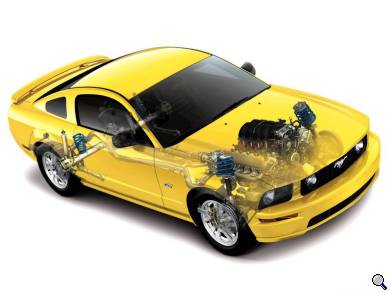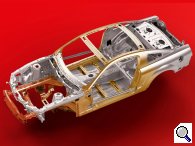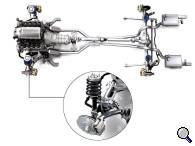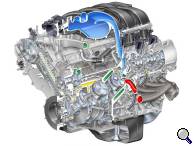
Since its dramatic 1964 introduction, Ford Mustang has been the icon of American performance and style, capturing hearts worldwide. For 2005, Mustang combines an all-new, fully modern architecture with all the soul that makes a Mustang a Mustang – bold style, a brawny engine and rear-wheel-drive excitement. In short, every inch of Mustang is new – yet it staunchly remains the genuine article – "America’s Car" for 40 years.
Based on an all-new, fully modern body structure and chassis system featuring advanced MacPherson struts and a three-link live axle with Panhard rod, Mustang boasts an overall ride sophistication unmatched by any of its ancestors. Its braking and handling are nothing short of world class.
 A new-from-the-ground-up chassis and careful attention to vehicle dynamics give the all-new Mustang world-class ride and handling. The starting point is an all-new, purpose-built, muscle-car platform with exceptional body stiffness and a very high strength-to-weight ratio. With this ultra-rigid structure, Mustang engineers could tune spring, damping and bushing rates to a finer degree than ever possible. Using computer-aided design and engineering technology, the Mustang team took months off the earliest phases of component development. That gave driving dynamics experts more time to work out final chassis tuning – and they used it to deliver an unprecedented combination of road handling and comfort in the 2005 Mustang.
A new-from-the-ground-up chassis and careful attention to vehicle dynamics give the all-new Mustang world-class ride and handling. The starting point is an all-new, purpose-built, muscle-car platform with exceptional body stiffness and a very high strength-to-weight ratio. With this ultra-rigid structure, Mustang engineers could tune spring, damping and bushing rates to a finer degree than ever possible. Using computer-aided design and engineering technology, the Mustang team took months off the earliest phases of component development. That gave driving dynamics experts more time to work out final chassis tuning – and they used it to deliver an unprecedented combination of road handling and comfort in the 2005 Mustang.
One of the more critical development areas was the front suspension, where the Mustang design team delivered a high degree of precision handling, coupled with a smooth ride, all while harnessing the power a top-of-the-line GT can deliver. Engineers carefully examined the BMW M3, a car believed by many to deliver just such qualities, before they laid out the Mustang's suspension. They used lessons learned from the M3 and the Lincoln LS to create the new Mustang's chassis design. Mustang engineers settled on using a coil-over MacPherson strut front suspension with reverse "L" lower control arms made of lightweight I-section steel. MacPherson struts – originally developed in the 1940s by Earl S. MacPherson, a Ford engineer – are widely renowned for their ability to deliver both comfort and control with reduced weight.
 The L-shaped lower control arms offer additional advantages over A-arm or wishbone-shaped suspension components when it comes to blending sure handling with ride comfort. A firm bushing is positioned at the point where the shorter forward leg of the L-arm connects to the chassis to control side-to-side motion and quicken steering response. The fore-and-aft movements are directed through a softer, compliant bushing at the longer, rear L-arm leg, which damps road shocks. This isolation is a direct benefit of the reverse L-configuration of the control arms.
The L-shaped lower control arms offer additional advantages over A-arm or wishbone-shaped suspension components when it comes to blending sure handling with ride comfort. A firm bushing is positioned at the point where the shorter forward leg of the L-arm connects to the chassis to control side-to-side motion and quicken steering response. The fore-and-aft movements are directed through a softer, compliant bushing at the longer, rear L-arm leg, which damps road shocks. This isolation is a direct benefit of the reverse L-configuration of the control arms.
Springs are mounted concentrically on the MacPherson struts in a coil-over-shock configuration. The layout allows the shocks to damp forces in the same vector as the spring, cutting friction and enabling more precise shock-valve tuning. A stabilizer bar – 34 mm on the GT and 28.6 mm for V-6 models – helps limit body roll.
Working on a clean sheet of paper, Mustang’s engineering team could have selected any type of setup at the rear, including an independent suspension. So why choose a solid rear axle? The answer lies in Mustang’s position as America’s sports car. Although a mainstay of muscle-car design, the solid axle hasn’t always been viewed as its strong suit. Early hopped-up sedans often overwhelmed their leaf-spring live axles, which weren’t designed for the demands of performance driving. The slender leaf springs were prone to side sway in hard maneuvers and to wind up and "hop" the rear wheels under full throttle. The tendency of the low-grip bias-ply tires of the day to lose traction and "burn rubber" actually was a blessing in disguise, as it took pressure off the suspension.
For 40 years, Mustangs have featured ever-improving solid rear axle designs. For 2005, Mustang’s rear suspension takes a completely different approach to combat wheel hop. Engineers opted for a three-link architecture with a Panhard rod that provides precise control of the rear axle. A central torque control arm is fastened to the upper front end of the differential, while trailing arms are located near each end of the axle.
A lightweight, tubular Panhard rod is parallel to the axle and attached at one end to the body and at the other to the axle. It stabilizes the rear axle side-to-side as the wheels move through jounce and rebound. It also firmly controls the axle during hard cornering. Constant rate coil springs and outboard shocks are tuned for a firm, yet compliant, ride. The shocks are located on the outside of the rear structural rails, near the wheels, reducing the lever effect of the axle and allowing more precise, slightly softer tuning of the shock valves. The GT version of the car incorporates a separate rear stabilizer bar to reduce body lean further.
The solid rear axle offers several other advantages that play to Mustang’s strengths. It is robust, maintains constant track, toe-in and camber relative to the road surface, and it keeps body roll well under control.
Bigger usually means better when it comes to brakes, but that is only part of the story behind the 2005 Mustang’s sophisticated standard four-wheel-disc braking system. Along with Mustang’s biggest-ever rotors and stiffest calipers, comes a new, four-channel anti-lock braking system. Standard on GT and optional on V-6, it enhances braking performance. In addition to helping prevent wheel lock-up, the new system has electronic brake force distribution, which distributes braking power to the wheels where it can be used most effectively.
Dual piston aluminum floating front calipers clamp down on 316 mm (12.4-inch) front brake discs on GT models – an increase of more than 15 percent in rotor size. On the GT, the brakes have 14 percent more swept area than those of the previous model. These rotors are 30 mm thick and are ventilated to provide consistent stopping power, even under the strain of excessive heat induced by repeated hard braking. The payoff comes in shorter stopping distances, better pedal feel and longer pad and rotor life.
In the rear, the brake rotors are 300 mm (11.8 inches) in diameter – more than 12 percent larger than the previous Mustang – and 19 mm thick. Rear rotors are vented on both the GT and V-6. Single-piston calipers sweep 18 percent more area than the rear brakes on the previous Mustang.
 A new V-8 engine pumps the Mustang GT up to an impressive 300 horsepower and 315 foot-pounds of torque – enough to get any muscle-car enthusiast’s heart racing. It marks the first time the mainstream Mustang GT offers 300 horsepower – formerly exclusive Mach 1, Cobra and Boss territory. The GT’s 4.6-liter, three-valve MOD V-8 packs 40 more horsepower than the current V-8 and more than 50 percent more power than the fiery small-block 289-cubic-inch V-8 that propelled the 1964 model to stardom. This new level of performance – on regular gas – is made possible by intelligent application of modern technology, including all-aluminum construction and a new head design that incorporates three valves per cylinder and variable cam timing.
A new V-8 engine pumps the Mustang GT up to an impressive 300 horsepower and 315 foot-pounds of torque – enough to get any muscle-car enthusiast’s heart racing. It marks the first time the mainstream Mustang GT offers 300 horsepower – formerly exclusive Mach 1, Cobra and Boss territory. The GT’s 4.6-liter, three-valve MOD V-8 packs 40 more horsepower than the current V-8 and more than 50 percent more power than the fiery small-block 289-cubic-inch V-8 that propelled the 1964 model to stardom. This new level of performance – on regular gas – is made possible by intelligent application of modern technology, including all-aluminum construction and a new head design that incorporates three valves per cylinder and variable cam timing.
Electronic throttle control is new to Mustang for 2005. Each engine has been tuned to provide heart-warming performance sound and feel, without unwanted noise, vibration and harshness. New, faster electronic processors with more computing muscle and memory enable Mustang’s more powerful engines to deliver even better fuel economy with lower emissions.
The V-8’s deep-skirt, lightweight aluminum engine block provides optimum stiffness and strength, saving 75 pounds compared with a cast-iron design. Computer-aided engineering was used to reinforce key areas of the block, adding rigidity without weight.
The lightweight hypereutectic aluminum pistons have short skirts, with an anti-friction coating that assures more of the power is delivered to Mustang’s rear wheels and less is lost to friction. High-tension piston rings provide better cylinder sealing for long-term durability and low oil consumption. The connecting rods use Ford’s cracked powdered metal manufacturing technique for precise fit. Five main bearings with cross-bolted main bearing caps further ensure durability and reduce flex. A tray attached to the main bearing caps baffles oil flow in the pan, reducing aeration and assuring proper oil feed to the crankshaft during the kind of sustained lateral maneuvers encountered in performance driving.
For refinement, the V-8 engine is installed using hydromount bushings on either side of the block. These liquid-filled engine mounts are tuned to quell specific unwanted vibration.
One of the keys to producing 300 horsepower from this relatively small displacement is Mustang’s new single-overhead-cam, three-valve cylinder head design with variable cam timing. The new head gives the engine a higher compression ratio than previously possible on regular 87 octane gasoline.
Air equals engine power, and the V-8’s heads use two intake valves per cylinder to move more air into the engine. A new, tuned-length exhaust manifold offers optimized exhaust flow to help scavenge burned gases from the cylinders.
Variable camshaft timing was a key in the quest to wring more power from the Mustang’s 4.6-liter, three-valve MOD V-8 engine, while simultaneously improving efficiency and reducing emissions. VCT lets allows the valves operate at optimum points in the combustion cycle, tailored to the engine’s speed and load at that instant.
Mustang’s sophisticated electronics system – five times faster and boasting up to eight times more memory than the previous generation EEC-V powertrain control module – constantly monitors an array of sensors to make thousands of split-second decisions.
The most important sensor for the all-new electronic throttle control system is the one at the driver’s right foot. Mustang’s powertrain computer infers the driver’s intent from the position of the accelerator pedal. It continually matches this information against other data – like engine speed and load – and electrically operates the throttle-body at the front end of the intake manifold to achieve results the driver demands.
For the first time, Mustang is available with a five-speed automatic transmission. The 5R55S automatic, also used in the Lincoln LS and Ford Thunderbird, has closely spaced ratios that keep the engine in its power band to produce better acceleration, with a wide ratio that provides remarkably good highway fuel economy. The new powertrain control computer delivers benefits in the transmission, as well as the engine, by precisely controlling shift duration and shift timing. Throttle position, engine speed, load, environmental factors and other parameters guide the transmission shift schedule. A new electronic interface lets the powertrain control module communicate with the automatic transmission 10 times faster than before. For the first time, powertrain engineers could match transmission controls with other sophisticated features like variable cam timing and electronic throttle control. As a result, the entire powertrain works together to deliver smooth performance.
For those who prefer to compute their own shift points, five-speed manual transmissions are standard on the GT version of the 2005 Mustang. The V-8 powered GT is equipped with a rugged Tremec 3650 gearbox. They now use a flange coupling instead of a splined drive with the driveshaft that results in better balance and reduced lash. An all-new shift linkage is designed to provide quick engagement of the gears, producing a solid feel and none of the "notchiness" apparent on some previous Mustangs.
In both automatic and manual transmission cars, Mustang GT models use a two-piece driveshaft that can withstand higher engine speeds and torque. V-6 models use a slip-in-tube driveshaft.
The rear axle ratio is 3.55:1 for the Mustang GT when equipped with a manual transmission. All other Mustangs use a 3.31:1 final drive ratio. The Mustang GT comes standard with a traction-lock 8.8-inch rear axle for smooth launches and better grip on loose or slippery surfaces.
All axles have a robust ring-and-pinion gear and feature a stiff differential case to reduce flex during cornering.
Ford Motor Company © 2005